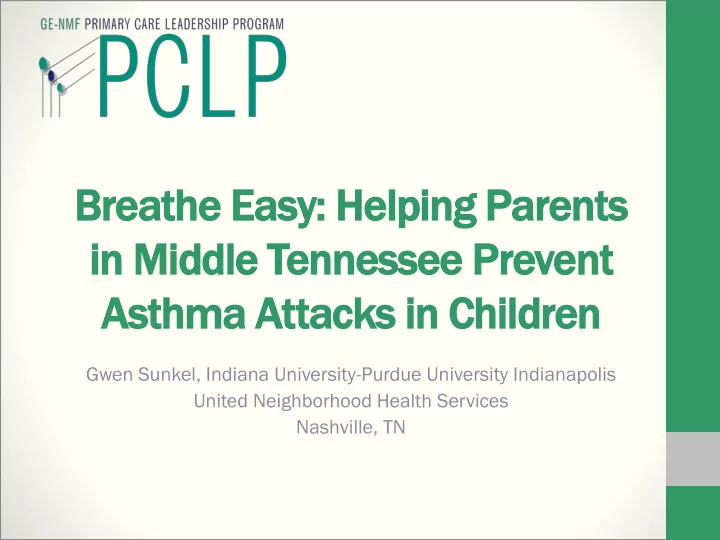

Breathe Easy: Helping Parents in Middle Tennessee Prevent Asthma Attacks in Children Gwen Sunkel, Indiana University-Purdue University Indianapolis United Neighborhood Health Services Nashville, TN
Introduction Gwen en Sun unkel, , RN Indi diana na University ty-Pu Purdue due Univer ersity sity Indi diana napoli polis • Senior FNP student • GE-National Medical Fellowships Primary Care Leader Scholar June 3 rd -July 12 th , 2013 • United Neighborhood Health Services, Nashville, TN • How does the environment affect health?
Background Asthma is common • 18.7 million people in US have asthma, 7 million children • Tennessee has 22 nd highest incidence in US Asthma is dangerous • 250,000 deaths worldwide in 2010 • Causes co-mordities Asthma is expensive • 56 billion dollars annually in US • Tennessee spent $179 million in 2010, 44% of those costs paid for by TennCare ($113 million for inpatient medical costs) UNHS patients are at increased risk for asthma complications • Increased incidence of smoking, low health literacy, environmental triggers in and out of home
Methodology Backgr ground ound Res esea earch ch Inter erven enti tion on • Creation of educational • Interviews with UNHS video reinforcing trigger providers — treatment, trends, avoidance, using inhalers observed knowledge deficits, correctly, and spacer use • Interviews with UNHS • Inhaler labels (rescue vs. patients — symptomatology, maintenance) medication usage • Translation into Spanish • Home risk assessments • Available to providers July 8 th • Regional environmental and climate data • Track number of visits r/t asthma exacerbations, • Statistics mined from refill requests for short NextGen EHR acting beta-2 agonists
Results Providers • Use EPR-3 prescribing guidelines, inconsistent use of non-pharmacologic interventions • Seasonal component to asthma exacerbations — more common in Spring and Fall • Knowledge deficit: misuse of short-acting beta-2 agonist vs. maintenance medication Patients • Frequent exposure to triggers • Improper use of inhalers Research • Low health literacy correlates with poorly controlled asthma • Educational interventions are effective in reducing the number of asthma exacerbations • Elevated Air Quality Index and Pollen Counts
Results Total UNHS Asthma Visits, 2010-Present
Results UNHS Asthma visits by age group, 2010-12
Results Number of Exacerbations by months, 2010-2012
Results Video available on YouTube, searchable under “UNHS asthma”
Results Spanish version, searchable under “UNHS Asthma Spanish”
Results Inhaler labels Rescue inhaler: Use ONLY during an asthma attack Maintenance Inhaler: Use ____x EVERY DAY to prevent asthma attack. Also available in Spanish
Discussion Educational video and inhaler labels met needs of UNHS patients and providers by being: Accessible • Per provider request, available on YouTube, can be watched in office on a Smartphone or tablet while provider charts or at home Easy to understand • Appropriate for patients with low health literacy (adults and children) • Addresses observed knowledge deficits — trigger avoidance, inhaler labels, spacer use Available in both English and Spanish • 20% of Tennessee’s Spanish speaking population lives in Davidson County • Consider offering in other languages
Recommendations • Utilization of EPR-3 guidelines for asthma management • Asthma Action Plan • Peak Flow Measurements Implementation of education interventions • Measure results after 6 months of use — decreased number of visits, esp. exacerbation related, fewer requests for rescue inhaler refills Reinforce education • Home visits--assess for presence of triggers • Access to video and written education materials Pay for performance Standards • Healthcare delivery systems responsible for asthma costs?
Conclusion United Neighborhood Health Services patients are at risk for asthma exacerbation due to increased exposure to triggers both inside and out of the home. Pediatric patients are the most because their lungs are still developing and cannot escape the asthma triggers surrounding them. Education programs designed to inform patients with low health literacy how to avoid asthma triggers and take medications correctly could result in better patient outcomes, fewer acute asthma exacerbations, and a reduced financial burden on the healthcare system.
Acknowledgements Tha hanks ks to: • The General Electric Company and the National Medical Fellowships for the opportunity to participate in the Primary Care Leadership Program • Samantha Haun and the staff at the National Medical Fellowships for their support during the PCLP fellowship experience • Dr. Lois Wagner, faculty advisor • United Neighborhood Health Services staff, providers, and patients for sharing their experiences on treating and living with asthma in Middle Tennessee • Andrea Ricke-Moore, RN, IT specialist, UNHS • Will Wyatt, Volunteer Coordinator, UNHS • Angela Valadez, RN • Carrie Bearn, for data management expertise
Recommend
More recommend